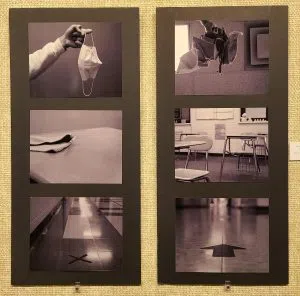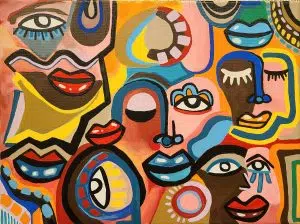The following article is written by Diana Bolander, Assistant Director/Curator of the Rahr-West Art Museum.
The Rahr-West Art Museum has a long history of hosting school exhibits during the months of March, April, and May but that has been on hold during the last year due to school and closures because of Covid-19. We are especially excited this year to be able to host art by high school students from the Big East Conference April 11 – 18. The Big East Conference includes Hilbert, Kohler, Mishicot, Oostburg, Ozaukee, Random Lake, Reedsville, St. Mary Catholic, Howards Grove, Sheboygan Lutheran, Sheboygan Christian, Cedar Grove-Belgium, Elkhart Lake-Glenbeulah, and Manitowoc Lutheran High Schools.
I spoke with this year’s exhibit hosts: art teachers Nathan Kilps, Northern Ozaukee High School, and Laura Adameak, Sheboygan Lutheran High School regarding this past year in their lives as teachers and the value of student work being presented publicly at the Rahr-West.
Why is it important that art be included in the curriculum?
Nathan Kilps: “Art education gives the students the distinct means to focus on subject matter pertaining to their own life, particularly their interests, aptitudes, and experiences. During the formative years of high school, students are developing understanding of identity. Therefore, it becomes vital for them to analyze the pertinent question of who they are lest they conform to whatever anyone tells them they need to be.
Art provides a safe space for students to explore the literal, the figurative, the imaginative, and the unknown. The ability to use different tools, media, and techniques provide physical means to explore and express their understanding to capture the moment of their life’s cross-section. Art allows students to construct their perception and exercise the concept of their being. Ultimately, art teaches the recognition of the encoding and decoding process of existence building independence — taking what is external, translating and measuring the experience into internal, understanding like or dislike, then translating it again through modes of expression — kinesthetic, visual, auditory… always a reflexive form of energy — that must both satisfy the maker and the viewer, resulting in a continual exercise of refinement. Simply put, art is an education in how students can do more and do better.”

“We survived, we revived, we thrived,” Kaela Groppel, Grade 12, St. Mary Catholic High School
What challenges have you and the students faced in the last year and how did you overcome them?
NK: “The students had trouble organizing their time in that they were not in physical classrooms. It was difficult as a teacher to help the students stay focused and help without being able to guide them throughout the making process. Since we have been back in the classroom we have started using logs. Students make their own goals and deadlines while making sure they are working on something each class.”
Laura Adameak: “Our school has been face-to-face this year, which I am thankful for. Teaching online is very different from teaching in-person classes. Teaching online this past spring, I had to be creative with potential projects that would allow students to use whatever materials had at home. I think the most rewarding aspect of teaching is developing relationships with students and I think this happens more naturally in a face-to-face setting — even with masks! I look forward to the day I get to see entire faces again.”

“Sonder,” Sarah Van Der Vaart, Grade 11, Kohler High School
Why is the student exhibit at the Rahr-West Art Museum important for your artists?
LA: “Exhibiting artwork is essential. Art is meant to be seen and shared. It gives students space to show their own unique view of the world. Having a professional space to do this in adds confidence and value to their work. It helps them see that art matters.”
NK: “It is important for the students to be able to display their work amongst their peers (especially for small schools like those in the Big East Conference) because it gives the students a chance to see what other schools and students their age are doing. It reaffirms the programs they are in. It also provides much-needed recognition that the arts and specifically their art is something worth recognizing at a museum level. Finally, it pushes the students to perform at a higher level when others outside of their immediate environments and social circles will view their work. The Rahr-West gives them a communal place to celebrate and appreciate art. It allows students to recognize what museums are for and illustrates how their work can be a part of our culture.”

“Stillness on the Morning,” Rylee Mohr, Grade 12, Reedsville High School
In what ways are you especially proud of the students for this year?
NK: “The students have truly been producing quality work this year. It is apparent the past year has caused students to reflect deeply on themes pertaining to society, government, personal beliefs, and overall being. The students have done a great job reflecting and addressing their perspectives in relation to what is being broadcast through news and social media.”
LA: “I think their ability to adapt to challenging situations in the classroom and at home this year is what makes me especially proud; their resilience. I think art helps them process their feelings about what is going on in the world, is helpful in giving them a space to process feelings, and provides them a voice.”
Former President Ronald Reagan said, “The arts… teach us who we are and what we can be. They lie at the very core of the culture of which we’re a part.” After a difficult year for all of us dealing with COVID 19, it is heartening to see the beauty in student-art borne out of tragedy, struggle, and ultimately resilience. The Rahr-West is honored and excited to share art from the students of Wisconsin’s Big East schools for the community to enjoy and be uplifted by. Please come and experience the art at the Rahr-West April 11 – 18. We hope to see you.













